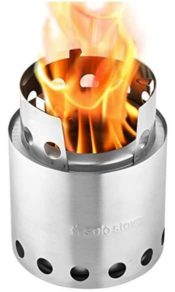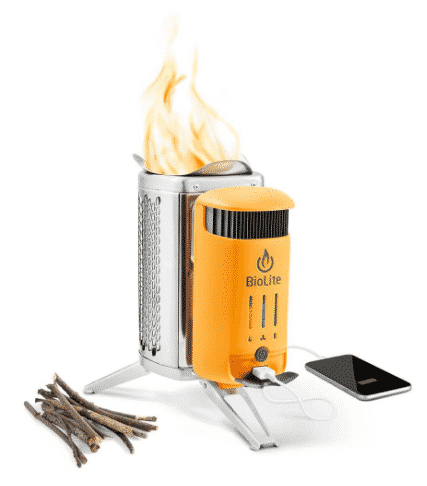
A Complete Guide To The Best Portable Stoves In An Emergency
Because a portable stove is both lightweight and compact.
We’re talking light enough to transport from place to place with ease.
The critical word here is; “ease.”
Sure, “technically,” you can move your kitchen stove, but not with ease.
Portable stoves are the kind you can pick up, pack, and store in a vehicle or backpack.
The best ones function nearly as well as your standard kitchen stove.
TOPICS IN THIS GUIDE… ↓(click to jump)
- Best Portable Stoves Today
- Stoves vs. Grills vs. Skillets
- Different Types Of Stoves
- Best Portable Stove Features
- Reasons To Invest In One
- A Few Stove Safety Tips
[
Best Portable Stoves On The Market Today
Over the years, we’ve had the opportunity to test many different stove models across various designs.
Each type has great features, but no stove can be the best for all situations.
Here are a few of our favorites for some of the most common stoves on the market today.
The quintessential camp stove that nearly everyone grew up with. The Coleman white gas stove has been a mainstay of the campground for decades.
Set on a flat surface like a picnic table, they opened like a suitcase. The lid and side screens provide wind protection.
They were easy to use and relatively indestructible - and you can find many from decades past still in use today.
Over the years, many other manufacturers have copied the design. There are now dozens of options.
Some are based on simpler propane burner designs that don’t require a large fuel tank.
You can find models with 2 burners and 20,000 BTU.
Others feature a single burner on one side and a griddle on the other for pancakes or eggs.
Adapters allow you to use large BBQ-style propane tanks.
Often fueling multiple stoves and even lanterns simultaneously, which is GREAT if you're car camping and cooking for more than a couple of people at a time.
If you’re traveling by car, inflatable boat, or horse, this is the camp stove you need!
↓ Coleman Triton Series 2 Burner Stove Review
↓ GasOne Mini Stove Gs-800 Review
Suitcase stoves may still dominate the campground; the backcountry belongs to JetBoil.
In the early 2000s, JetBoil released its “personal cooking system.” It was a combination of a small butane canister and a miniature stove.
One with an insulated 1L cooking pot and an integrated heat exchanger.
The whole thing snapped together. This means keeping things from tipping and simplifying cooking.
Boiling 1L of water took only 2-3 minutes, lightning-fast compared with other stoves of the day.
When finished, the entire system nests inside the cooking pot and slips easily into a pack.
Now, the original JetBoil has been replaced by the JetBoil Flash. A new version of the JetBoil with an improved heat exchanger and lighter materials.
It’s an excellent option for one person, especially if you have a lot of freeze-dried meals!
↓ Jetboil Flash Cooking System Review
When every ounce matters, even the JetBoil seemed like a brick of lead to the designers at SnowPeak.
A company dedicated to super lightweight gear for thru-hikers.
When you’re hiking 20-30 miles per day, a 2oz stove that fits inside a coffee cup is an impressive upgrade.
SnowPeak has upped the game with their LiteMax Titanium. Cutting weight while bringing the boil time down to just over 4min for 1L of water.
There are few moving parts, making it reliable and simple to set up.
↓ Gear Review: Snow Peak Gigapower Lite Max Stove
How about investing in the #1 wood-burning backpacking stove recommended by Backpacker Magazine?
If you want a wood-burning backpack stove, then look no further than the Solo Stove.
These compact stoves have proven themselves to be lightweight and efficient. Plus, you don't need to carry any fuel canisters around with you.
Just pick up the twigs and small branches on the ground, use a bit of fire-starting tinder, and you'll be cooking your meal in no time.
↓ Solo Stove Titan Review (Cool Wood Burning Camping Stove)
The BioLite CampStove 2+ is the latest in portable stove technology!
The BioLite Stove is a wood-burning backpacking stove that allows you to turn the heat you generate from twigs and sticks into usable electricity.
The unit weighs a bit more than the Solo Stove; however, that extra bit of weight comes with a very nice feature.
There is just something awesome about being able to use your portable stove for cooking a meal and charging your phone at the same time!
↓ BioLite Camp Stove 2 Charging With Fire!!
An alcohol-based portable burner stove is not for everyone, but some people absolutely love it.
Why the disparity? Because it's an alcohol burner.
It's one of the most versatile and user-friendly alcohol burners on the market.
The Trangia's O-ring lined screwcap allows you to store excess fuel inside the stove without leakage.
The stove could hardly be simpler to operate. Just fill it up with your preferred alcohol fuel and light it aflame with a match, lighter, or fire rod.
Simple, lightweight, and user-friendly, what's not to like?
↓ Alcohol Stove Review | TA Outdoors
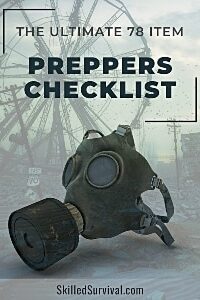
Want a free 78 item preppers checklist?
Enter your email below to instantly download this Complete Checklist PDF. No purchase necessary. 👇 👇Stoves Vs. Grills Vs. Skillets
Before we can get into all the different types, it’s wise to sort out all the confusion between stoves, grills, and skillets.
Here’s the simplest way to think about the differences:
- Stoves = Cooking food in pots, pans, or special cups over a controlled flame
- Grills = Cooking food directly over grates (without pots or pans)
- Skillet = Cooking food directly over a flat heated surface (again, without pots or pans)
See, that wasn’t so hard.
Now you can impress all your camping and survival buddies with this new-found knowledge!
And more importantly, you have a better sense if you’re truly in the market for a stove, grill, or skillet.
Different Types Of Portable Stoves
There are several categories; each has pros and cons depending on your goals.
Here are the major categories:
1. Fuel Source Categories
- Portable Electric Stoves
- Portable Gas Stoves
- Propane Stoves
- Butane Stoves
- Wood Burning Backpacking Stoves
So let’s go through each of these categories in detail:
↓ What Is The Best Survival Cooking Stove?
Portable Electric Stoves
Regarding “plug and play,” electric stoves are the easiest and most convenient.
You don’t have to worry about buying and storing propane canisters.
However, that convenience is a double-edged sword.
Electric stoves only make sense at locations with reliable (and abundant) power.
So they work great at modern campsites (with electrical hookups).
However, if the power goes out, your portable electric stove becomes a large, expensive paperweight!
So a portable electric stove is OK for certain locations, but it’s not versatile enough for my liking.
If you want a stove that will work anywhere (no matter the circumstances), skip an electric one.
Portable Gas Stoves
Today, one of the most popular options burns liquid gas.
Here’s a list of the liquid gas choices:
- Kerosene
- White gas
- Gasoline
- Alcohol
- Methanol
- Ethanol
Some stoves can burn multiple fuel types without any modification, which is a nice feature!
Other stoves need specific jet nozzles for each fuel type, which can be a pain.
Some portable gas stoves are designed to only work with one gas.
Many liquid stoves require some pressurization or priming before they start.
Some even need pressurization control during the operation.
Nowadays, most gas-fueled stoves burn either propane or butane.
Propane
Propane is easier to find and performs better in the cold.
However, the containers are often heavier, which is a concern for backpacking.
Butane
Butane stoves have a very high heat output per weight.
This makes them fuel-efficient but prone to scorching rather than simmering.
Butane containers are smaller and not refillable.
Both options are about as simple as it gets.
Just attaching the fuel canister, turning a valve, and lighting the burner – that’s it.
However, with either gas stove, you can cook a meal anywhere – as long as you don’t forget to pack (or run out of) fuel canisters.
So double-check all your essential camping gear before heading out, and you’ll be fine.
Note: Gas stoves are rated in British Thermal Units (BTUs), allowing you to compare the maximum heat output between stoves.
Wood Burning Backpacking Stoves
Finally, the new kid on the block is wood-burning backpacking stoves.
These units are becoming more popular with campers, backpackers, and backyard bonfires.
You haul the stove around and feed it using downed twigs and branches.
The smaller versions take a few sticks, while larger ones need branches.
For some campers, worrying about transporting gas is a hassle, especially those interested in self-reliance.
These units don’t care if the power is out or you run out of propane.
You eliminate these headaches with a portable wood-burning stove.
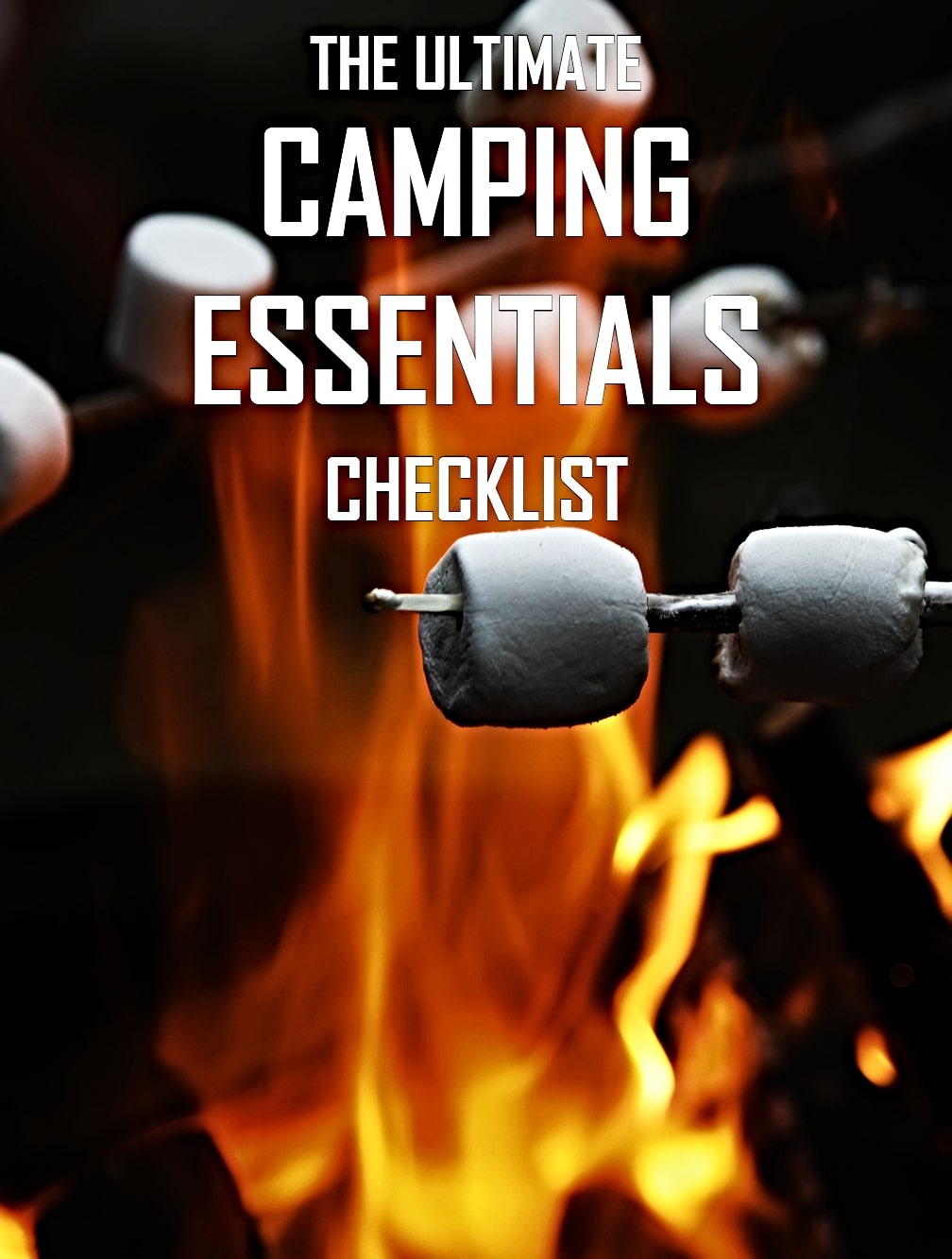
Want a free camping essentials checklist?
Click here to instantly download this Complete Checklist PDF. No purchase necessary.Best Portable Stove Features
The best stoves share several key features:
Lightweight
The “portable” part of the equation means the stove is lightweight, but that can mean different things to different users.
A backpacker may consider anything over a couple of ounces is too heavy.
While someone who’s traveling by car, boat, or horse may be happy with a camp stove weighing several pounds.
So pay close attention, but generally, the lighter, the better.
Durable
Anything designed to be portable is bound to get banged around every once in a while.
If you’re lucky enough to stay in one place, that can be minimal after the initial setup.
However, if you’re always on the move, that means extra wear and tear on valves, fuel lines, and moving parts.
Even dropping your heavy pack down hard to rest can cause a permanent malfunction.
This abuse makes a durable, proven design a must.
Reliable
Something as crucial as a stove should be reliable if it’s worth adding to your camping gear or survival gear.
This means it has to light under just about any conditions – wind, rain, high altitude, cold.
Many stoves have a piezoelectric starter.
I keep some windproof matches and a survival lighter in case the igniter fails.
A repair kit for crucial parts and the knowledge of how to use it can also be a lifesaver.
Easy To Use
Another critical factor in choosing a camping stove is its ease of operation.
You may want one with fine-tuned controls.
The simplicity of design, setup, and availability of fuel all play into this factor.
That’s why heat control is one of the most important variables.
Some stoves are hard to put together but work almost like a standard kitchen stove once set up.
Others are simple to set up but need tedious adjustments and fuel management.
At the end of the day, choose one that matches your abilities.
Ignition Options
The “best” ignition setup depends on your skills and abilities.
Some stoves come with auto igniters; others have push-button igniters, while minimalist wood stoves don’t have either.
If starting a fire is challenging for you, go with an auto igniter.
If you’re a master (and can even start a fire with sticks), then a compact wood stove may be best.
Reasons To Invest In A Small Stove
Nowadays, modern stoves are designed with camping trips and recreation in mind.
- From backpacking stoves only weighing a few ounces.
- To “suitcase stoves” with several high-output burners.
But to make a wise purchase, you must understand what, where, and how you want it.
Camping Stove
Camping stoves make an excellent addition to your camping essentials list.
Sure, occasionally, I enjoy cooking my camp meals over a campfire.
But more often, cooking over a stove makes more sense.
One reason is to manage the high cost of firewood.
Instead of using costly firewood for your meals, save your firewood for sitting around after the sun goes down!
Not to mention the increase in widespread summertime campfire bans across the arid US.
Because there’s nothing quite as disappointing as showing up at a campsite with no way to cook your food.
If you’re only cooking method a campfire, and there’s a fire bane – you’re going to be one unhappy camper 🙁
Backpacking Stove
Backpacking and portable go together like macaroni and cheese – which is to say they are inseparable.
If a piece of gear is not portable, it’s not for backpacking.
That’s why many backpackers add super minimalistic, lightweight ones to cook their freeze-dried backcountry meals.
Sure, you can pack meals that don’t require a stove, and many backpackers do this.
However, a warm, filling meal on the trail is hard to pass up.
Adding one to a backpack is doable with the minimalist, lightweight stoves on the market today.
Bugging Out
Bugging out and backpacking are technically very similar.
With both activities, you carry gear in a backpack to survive a long-distance trek.
However, you do this with backpacking to enjoy nature and explore the wilderness.
With bugging out, you’re preparing for a dire emergency when forced to leave your home.
But regardless, compact stoves are an ideal solution for both situations.
Power Outage Emergencies
What’s your survival cooking strategy?
How do you plan to cook food if electricity is out for several weeks, a month, or a year?
Extreme? Maybe, but we like to plan for the worst and hope for the best.
So having a portable stove (and a means to fuel it) not only provides you with warm meals just about anywhere.
It also provides a warm meal anytime – even if the power is out indefinitely.
Investing in some piece of mind is always a good thing.
Survival Emergencies
In wilderness outdoor adventures, every member of your family (or group) should have a lightweight stove.
If you get split up, a single stove won’t cut it.
Someone will be without an emergency stove – a dangerous situation for survival.
They don’t all have to be able to cook a 4-course meal.
But everyone should carry a stove capable of heating up a freeze-dried meal or boiling water to make it safe for drinking.
Tailgating
Tailgating and grilling go hand in hand, so many people use a portable grill.
And while that works fine, maybe you’d prefer a stove instead.
With a stove, you can pan-sear just about any tailgate food you can think of.
Plus, you can keep your cheesy salsa warm on a low burner!
Camping Stove Safety Tips
Of course, any article about stoves has to include safety tips and warnings.
A glance at a manual for any stove, and you’ll see it comes with pages of warnings.
What does it all boil down to in the end?
Make sure you read all the warnings thoroughly, but here are a few highlights:
Stoves get hot. (Duh!)
Even after you turn them off, most stoves remain hot for several minutes (or longer).
You can burn yourself or your gear if you don’t let them cool before packing away.
Fuels Release Toxic Fumes
Burning any fuel releases carbon dioxide and other exhaust gases into the atmosphere.
Without ventilation, operating a stove in an enclosed space can be dangerous.
Open some vents for fresh air if you need shelter from the weather while cooking.
Be careful with stove fuel.
You should clean all fuel spills immediately but with care.
In extreme cold, spilling fuel on exposed skin can cause frostbite as the fuel evaporates.
Also, allow any fuel vapors to dissipate before starting a stove.
A spark can create a dangerous flash explosion if excess fuel vapors accumulate.
Cannot Fly With It
If you plan to fly with a stove, taking fuel (or even used, empty fuel bottles) with you on the plane is nearly impossible.
So consider fuel availability at your destination when selecting your stove.
Final Thoughts
If you’re this far into the article, you’re serious about investing in a quality portable stove.
However, to get the right one for you, it’s important to understand how to intend to use it.
You should also make sure it has all the key features you want.
Once you’ve done that, you can purchase with confidence.
A purchase you can be proud of and will last a lifetime.

Prepare, Adapt & Overcome,
P.s. - I just found out 2 out of 3 Americans don’t feel prepared for a 3 day disaster!!!
I guess this goes to show how modern society continues to embrace ‘living a fragile life.’ What’s crazy is… it’s so easy to fix.
To make sure YOU have the basics, watch our FREE training on “10 Simple Steps To Basic Preparedness” that shows you HOW.
Nothing crazy here… this isn’t doomsday prepping... just the basics every responsible adult should have before a disaster strikes.Why You Can Trust Skilled Survival...
Go here now to review a full breakdown of:
- Who We Are
- Our Credentials
- Our Mission
- & Product Recommendations...
Here are a few highlights of our teams credentials & certifications:
- Certified Member of a Mountain Search & Rescue Organization
- Plant Emergency & Safety Leader for a Major Food Manufacturer
- Member of the 10TH Mountain Division Hut Association
- Certifications: Avalanche 1, WFR, CPR
- Official Gear Tester for Numerous Outdoor Gear Companies
- Countless Multiday Backpacking trips into Remote Wilderness
- Bachelor's Degree In Mechanical Engineering
- Bachelor's Degree In Civil Engineering
- Bachelor's Degree In Biomedical Engineering
"It takes 20 years to build a reputation and five minutes to ruin it." - Warren Buffett
We're fully aware that trust is NOT something you GET but is EARNED.
And we'll continue to earn YOUR trust through our forthright and honest approach with each new Blog Post, Guide & Product we create...
P.s - I just took this FREE 60-second 'Readiness Score Quiz'👇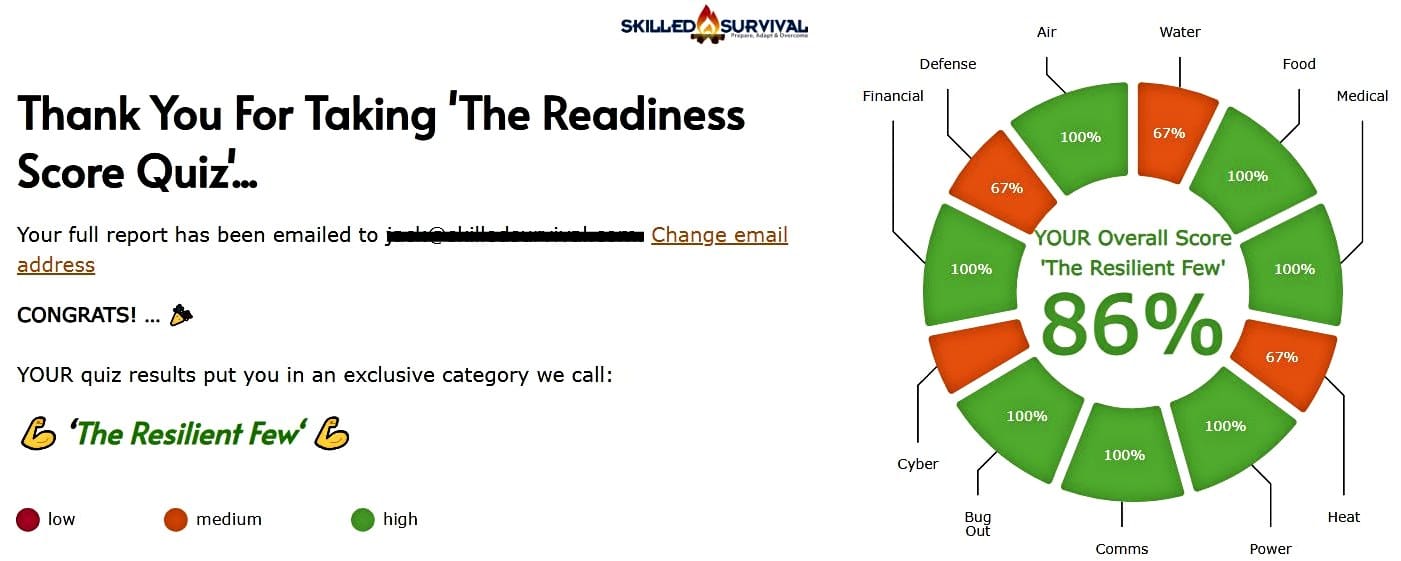
AND... I've still got a few gaps in my preps...🤔 But at least, I'm not part of 'The Fragile Masses'. 👍 Find out where YOU stand by answering a few questions...
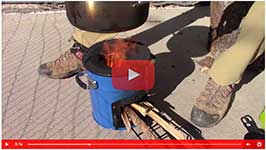
Recommended Reading
Minimalist Camping: How To Avoid The Most Costly Mistakes
Minimalist camping is a great way to practice wilderness survival. Here's a short list of the limited items to take on your next camping trip
How To Make Money With Land: 22 Creative Ideas
The best 22 ways I know of on how to make money with land. Pick and choose the ones that will work best for you property and situation.
Best Cold Weather Tents To Survive Below Freezing Temps
Not all tents are created equal, and most are NOT good enough for winter camping. Here are the best cold weather tents for sale today.
Camping Essentials Checklist: 21 Items You’ll Regret Forgetting
A 21 camping essentials checklist to ensure you never forget the most important gear on your next trip. 1. Tent 2. Water 3. Food 4. Knife...
Best Canvas Tents For Epic Camping, Hunting & Survival
The best canvas tents are durable, waterproof, mold resistant and 100% worth owning! In this guide, we review the best ones on the market to make your search easy.
Best Portable Solar Chargers: Power For Off Grid Adventures
The best portable solar chargers are innovative, durable, waterproof and 100% worth owning! In this guide, we review the best ones to make your search easy.





